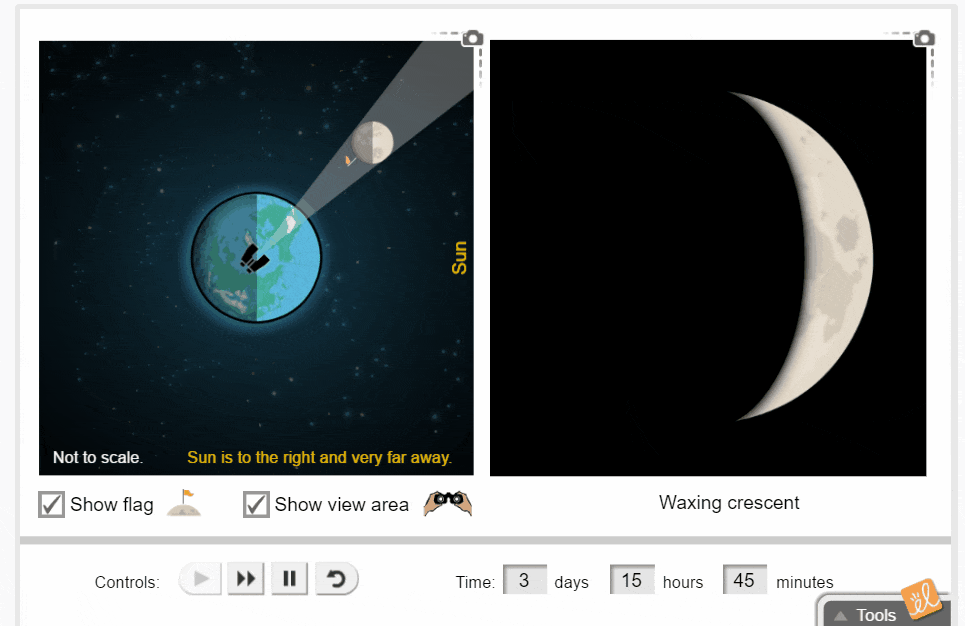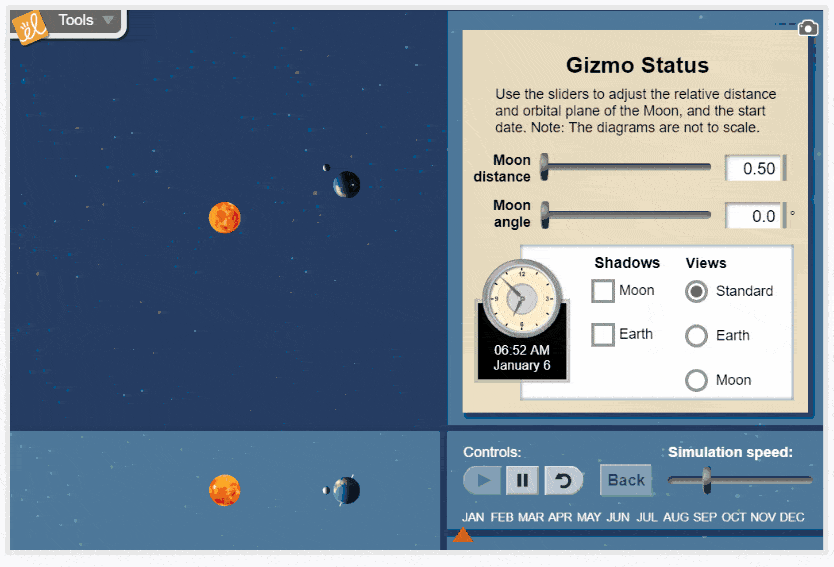
Kids have been looking at the Moon since they were young. Many children’s books, movies, and shows revolve around the Moon. While students are familiar with the Moon, most don’t know a Waning Crescent from a Waxing Gibbous. Studying the phases of the Moon is important to build foundations for learning about seasonal changes, astronomy, daylight and darkness times, and the organization of time.
What are the phases of the Moon?
Looking up at the night sky, it’s easy to see that the Moon changes shape. Most people can recognize a Full Moon or a Crescent. Different parts of the Moon are illuminated by the Sun as it circles the Earth, resulting in the various shapes or phases of the Moon. Those phases impact tides and water levels, but the Moon phases affect more than that. The phases of the Moon also influence time and the hours of daylight and darkness. For many animals, the Moon is essential to migration and navigation. Teachers often say it’s easy to tell when there’s a Full Moon based on the students' behavior.
Understanding the solar system and Moon orbit
How does the Moon's orbit connect to the bigger picture of the solar system? The Moon looks different because of the changing positions of the Sun, Earth, and the Moon. While the shape of the Moon appears different throughout the month, it isn’t really changing. It’s our view of the Moon that changes. Because the Moon doesn’t produce its own light, it would be completely dark without light from the Sun, the only light source in our solar system. The phases of the moon are basically the parts that are illuminated by the Sun, which is the side facing the Sun.
Identifying the eight distinct phases of the moon
What are the phases of the moon? Let’s start with a New Moon when sunlight illuminates only the far side of the Moon, which is the side we can’t see from Earth. A Full Moon is when sunlight illuminates only the near side of the Moon or the side that faces Earth. The cycle repeats itself every 29.5 days or about once a month, resulting in eight different Moon phases.
There are eight Lunar Phases with their own unique names and shapes. For quick reference, let’s break down some of the basics. Waxing means that the shape is growing. Crescent refers to the sliver shape of the Moon. Waning means shrinking or getting smaller. Gibbous refers to the oval or round shape. The phases, in order, as viewed from the Northern Hemisphere on Earth, are:
- New Moon- the invisible phase of the Moon because we can’t see it
- Waxing Crescent- a thin sliver of the Moon on the right
- First Quarter- half of half of the surface is illuminated
- Waxing Gibbous- between a Half Moon and Full Moon and growing
- Full Moon- completely illuminated
- Waning Gibbous- between a Full Moon and a Half Moon and getting smaller
- Third Quarter- half of half of the surface is illuminated, opposite to the First Quarter
- Waning Crescent- a thin sliver of the Moon on the left

Interactive activities to teach Moon phases to kids
There are so many options for teaching Moon phases. Using a Phases of the Moon worksheet is simple, but a Phases of the Moon activity would be more fun and stimulating for students.
- Use chocolate sandwich cookies with icing to teach Moon Phases. Students can make the different phases by removing some or all of the icing.
- Ask students to view the Moon each night for a period of time and illustrate their observations using the proper names for the phases.
- If a field trip is an option, visit a local planetarium or observatory.
- Combine science and writing by assigning students to create a song or rap based on the phases of the Moon.
- How about using a Moon phase simulator? Gizmos offers a Moon phase simulation that allows students to do more than simply observe them.
Spark celestial magic: Moon phases and eclipses with Gizmos
With the Phases of the Moon Gizmo, students explore the phases of the Moon by observing the positions of the Moon, Earth, and Sun. They learn the order of the Moon's phases and watch as the Moon orbits Earth. Every Gizmo includes lesson planning materials, teacher guides, vocabulary sheets, and student worksheets to build conceptual understanding. Look for the new Elementary Literacy Connection for this Gizmo for cross-curricular activities. Learning objectives for this virtual simulation include:
- Define rotation and revolution.
- Explain why we see Moon phases.
- Relate Moon phases to the Moon’s position.
- Name the phases of the Moon and list them in order.
- Notice that we always see the same face of the Moon.
- Explain the meaning of a year and a day.
- Find the length of a lunar year and day.

Don’t just talk about the Phases of the Moon. Let your students experience them. The Phases of the Moon Gizmo is part of the current Free Gizmos collection.
Explore the Moon Phases GizmoDid you know that an eclipse is coming? On April 8, a total solar eclipse will occur. The Moon’s shadow will pass over the middle of North America. You might be lucky enough to be in the path of totality for this once-in-a-lifetime experience! (Just don’t look directly at the eclipse unless you have specialized equipment.)

What’s another option? The 3D Eclipse Gizmo, of course, which is free for a limited time (through April 10, 2024).
Get the 3D Eclipse Gizmo
Access a rotating collection of free Gizmos from our library of over 550 math and science labs and simulations.
Access Free Gizmo